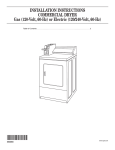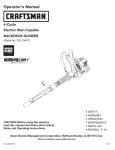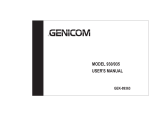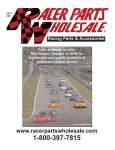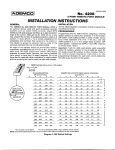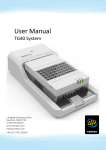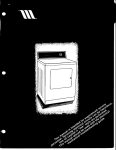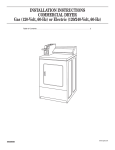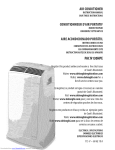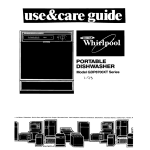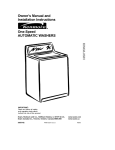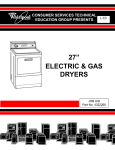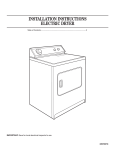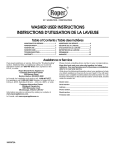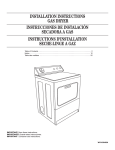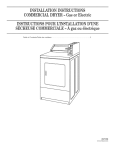Download 85772"_3 www.whNpooLcom
Transcript
85772"_3 www.whNpooLcom TABLEOF CONTENTS DRYER SAFETY ............................................................................ 2 iNSTALLATiON REQUIREMENTS 4 .............................................. Location Requirements .............................................................. Tools and Parts .......................................................................... 4 4 Ebctricat Requirements 6 ............................................................ Gas Supply Requirements ........................................................ 7 Venting Requirements .............................................................. 8 INSTALLATION INSTRUCTIONS = GAS DRYER .................. 10 Move Dryer into Position .......................................................... Make Gas Connection .............................................................. Connect Vent ............................................................................ 10 10 10 Complete InstaUation .............................................................. 10 INSTALLATION INSTRUCTIONS = ELECTRIC DRYER ........ 11 Move Dryer Into Position .......................................................... Make Electrical Connection ...................................................... 11 11 Connect Vent ............................................................................ 15 Complete InstaUation .............................................................. 15 DRYERSAFETY Your safety and the safety of others are very important. We have provided many important safety messages in this manual and on your appliance. Always read and obey all safety messages. This is the safety alert symbol. This symbol alerts you to potential hazards that can kill or hurt you and others. All safety messages will follow the safety alert symbol and either the word "DANGER" or "WARNING." These words mean: You can be killed or seriously injured if you don't immediately follow instructions. You can be killed or seriously injured if you don't follow instructions. All safety messages will tell you what the potential hazard is, tell you how to reduce the chance of injury, and tell you what can happen if the instructions are not followed. it is recommended that the owner post, in a prominent location, instructions for the customer's gas. This information should be obtained from your gas supplier. use in the event the customer smells Post the following warning in a prominent location. and liquids the vicinity of this or any other appliance. I Do not store or use gasoline or other flammable vapors FOR YOUR in SAFETY WARN(NG: For your safety, the information the risk of fire or e×p(os(on, or to prevent in this property - Do not store or use gasoline or any other app(iance. or other flammab(e - WHAT TO DO IF YOU SMELL GAS: manua( must damage, vapors be followed persona( injury, to m(n(mize 1 or death. 1 and Hqu(ds in the vicinity of this ® Do not try to Hght any appl(ance. ® Do not touch any e)ectr(ca( switch; do not use any phone in your bui(ding. ® C(ear the room, bui(ding, or area of aH occupants. ® Immediate(y call your gas supplier from a neighbor's phone. Follow the gas suppHer's instructions. ® ff you cannot reach your - hstaHation and service the gas supplier. In the State of Massachusetts, gas supp(ier, must call the fire department. be performed by a qualified installer, service agency, or the following installation instructions apply: m InstalIations and repairs must be performed by a qualified or licensed contractor, plumber, or gasfitter qualified or licensed by the State of Massachusetts. m If using a ball vaIve, it shaiI be a T-handle type. m A flexible gas connector, when used, must not exceed 3 feet. iMPORTANT SAFETY iNSTRUCTiONS WARNING: To reduce the risk of fire, electric shock, or injury to persons when using the dryer, follow basic precautions, including the following: m Read all instructions m Do not place items exposed to cooking oiIs in your dryer. Items contaminated with cooking oils may contribute to a chemicai reaction that could cause a load to catch fire. before using the dryer. m Do not dry articles that have been previously cleaned in, washed in, soaked in, or spotted with gasoline, drycleaning solvents, other flammable, or explosive substances as they give off vapors that could ignite or explode. m Do not allow children to play on or in the dryer. Close supervision of children is necessary when the dryer is used near children. Do not repair or replace any part of the dryer or any servicing unless specifically recommended Use and Care Guide or in published user-repair tions that you understand and have the skills to attempt in this instruccarry out. m Do not use fabric softeners or products to eliminate static unless recommended by the manufacturer of the fabric softener or product. m Do not use heat to dry articles containing foam rubber or similarly textured rubber-like materials. m Clean lint screen before or after each load. m Keep area around the exhaust opening and adjacent surrounding areas free from the accumulation of lint,dust, and dirt. m Before the dryer is removed from service or discarded, remove the door to the drying compartment. m Do not reach into the dryer if the drum is moving. _, The interior of the dryer and exhaust vent should be cleaned periodica!ly by qualified service personnel. m Do not instal! or store the dryer where it will be exposed to the weather. _, See installation instructions m Do not tamper with controls. for grounding requirements. SAVE THESE iNSTRUCTiONS iMPORTANT: The gas instaiiation must conform with local codes, or in the absence of local codes, with the National Fuel Gas Code, ANSI Z223=1/NFPA 54 or the Canadian Naturat Gas and Propane Installation Code, CSA B149=1= The dryer must be electrically grounded in accordance with local codes, or in the absence of local codes, with the National Eiectrica( Code, ANSI/NFPA 70 or Canadian Electrical Code, CSA C22,1, iNSTALLATiONREQUIREMENTS Gather the required tools and parts before starting installation. Read and follow the instructions provided with any tools listed here. Tools needed m 8" or 10" pipe wrench 8" or 10" adjustable wrench Flat-blade screwdriver Explosion Phillips screwdriver Hazard Adjustable wrench that opens to 1" (2.5 cm) or hex-head socket wrench Keep flammable materials and vapors, such as gasoline, away from dryer. Level Do not install in a garage. %6"socket wrench Failure to do so can result in death, explosion, or fire. Utility knife Vent clamps Pipe=ieint compound resistant to LP gas Caulk gun and caulk (for installing new exhaust vent) Pliers If installing [] Check code requirements: Some codes limit or do not permit installation of clothes dryers in garages, closets, or sleeping quarters. Contact your local building inspector. [] Make sure that lower edges of the cabinet, plus the back and bottom sides of the dryer, are free of obstructions to permit adequate clearance of air openings for combustion air. See "Recessed Area and Closet Installation Instructions" below for minimum spacing requirements. Putty knife Parts supplied Remove parts bag from dryer drum. Check that all parts were included. [] Dryer foot (4) a gas dryer: iMPORTANT: Observe all governing codes and ordinances. NOTE: The dryer must not be installed in an area where it wilI be exposed to water and/or weather. Recessed Area and Ctoset Installation instructions This dryer may be installed in a recessed area or closet. For recessed area and closet installations, minimum clearances can be found on the serial tag on the dryer. The installation spacing is in inches and is the minimum allowable. Additional spacing should be considered for ease of installation, servicing, and compliance with local codes and ordinances. If closet door is installed, the minimum unobstructed air opening in the top and bottom is required. Louvered doors with equivalent air openings are acceptable. The dryer must be exhausted outdoors. No other fuel-burning appliance may be installed in the same closet as the dryer. Minimum [nstaB[ation Clearances 14" Product Dimensions -- 29" (73.7 cm) (35.6 cm) msx. 15" (3&1 cm)* Closet door < f 16 _ (0 am) ! (40.6 cm) ELECTRIC !_---------_ I o" (ocm) O" (O cm) 141%2 ' [ 1" (2.5 cm) _/ ;m_E Recessed front view Closet side view 4" "--'[ "_ (10.2cm) dia. 281/4'' (71 _8cm) 4¾" Additional clearances for wall. door and floor moldings may be required or if external exhaust elbow is used. 183Z-W , [ 1 V4" (3.2 cm) (46.7 cm) Back view 3" (7.6 cm) Front View 24 in_ O closet door _<. 25 if,,, (64 _ crn) f _- (155 cm2)* 3" (7_6 cm) 7W' (18.1 cm) *Opening is the minimum for a closet door. Louvered doors with equivalent air openings are acceptable. 35" (88.9 cm) (2.5 cm) Side view !!!!iL;i_i:i:Mi,i:t;i!di _:i_i:i!!_i:FstiM:!_fi:i_ii!tiiii_ii:tii_ ,,,(_i!iiiil!i}ii_7_ii_! '_ iMPORTANT: The dryer must be electrically grounded in accordance with local codes and ordinances or, in the absence of local codes, with the National Electrical Code, ANSI/NFPA 70, latest edition. The National Electric Code requires a 4-wire supply connection for homes built after 1996, dryer circuits involved in remodeling after 1996, and all mobile home installations. Electrical Plug into a grounded Shock Hazard 3 prong outlet. Do not remove ground A copy of the above code standards can be obtained from: National Fire Protection Association One Batterymarch Park, Quincy, MA 02269 prong, Do not use an adapter, Do not use an extension [] cord. Failure to follow these instructions fire, or electrical shock, can result in death, IMPORTANT: The dryer must be electrically grounded in accordance with Iocal codes and ordinances or, in the absence of local codes, with the National Electrical Code, ANSI/NFPA 70, latest edition. if codes permit and a separate ground wire is used, it is recommended that a qualified electrical installer determine that the ground path is adequate. A copy of the above code standards can be obtained from: National Fire Protection Association One Batterymarch Park, Quincy, MA 02269 [] A 120-volt, 60-Hz, AC-only, 15- or 20-amp, fused electrical circuit is required. A time-delay fuse or circuit breaker is also recommended, it is recommended that a separate circuit serving only this dryer be provided. Recommended Ground Method The dryer, when installed, must be electrically grounded in accordance with Iocal codes or, in the absence of local codes, with the National Electrical Code, ANSI/NFPA 70, latest edition, and all local codes and ordinances. GROUNDING INSTRUCTIONS For a grounded, cord-connected dryer: This dryer must be grounded, in the event of a malfunction or breakdown, grounding will reduce the risk of eIectdc shock by providing a path of Ieast resistance for electric current. This dryer is equipped with a cord having an equipmentgrounding conductor and a grounding plug. The pIug must be pIugged into an appropriate outlet that is properly installed and grounded in accordance with aII local codes and ordinances. WARNING: improper connection of the equipmentgrounding conductor can result in a risk of electric shock. Check with a qualified eIectrician or service representative or personnel if you are in doubt as to whether the dryer is properly grounded. Do not modify the plug provided with the dryer: if it wiii not fit the outlet, have a proper outlet installed by a qualified electrician. SAVE THESE 6 if codes permit and a separate ground wire is used, it is recommended that a qualified electrical installer determine that the ground path is adequate. INSTRUCTIONS A four-wire or three-wire, single-phase, 120/240-volt, 60-Hz, AC-only electrical supply (or four-wire or three-wire, 120/208-volt, if specified on the model/seria! rating plate) is required on a separate, 30-amp circuit, fused on both sides of the line. A time-delay fuse or circuit breaker is recommended. Recommended Ground Method It is your responsibility to contact a qualified electrical installer to ensure that the electrical installation is adequate and in conformance with the National Electrical Code, ANSI/NFPA 70, latest edition, and all local codes and ordinances. GROUNDING INSTRUCTIONS For a grounded, cord-connected dryer: This dryer must be grounded, in the event of a malfunction or breakdown, grounding will reduce the risk of electric shock by providing a path of Ieast resistance for electric current. This dryer uses a cord having an equipment-grounding conductor and a grounding pIug. The plug must be pIugged into an appropriate outlet that is properly installed and grounded in accordance with all local codes and ordinances. _' For a permanently connected dryer: This dryer must be connected to a grounded metal, permanent wiring system, or an equipment-grounding conductor must be ran with the circuit conductors and connected to the equipment-grounding terminal or lead on the dryer. WARNING: improper connection of the equipmentgrounding conductor can result in a risk of eIectric shock. Check with a qualified eIectrician or service representative personnel if you are in doubt as to whether the dryer is propedy grounded. Do not modify the plug on the power suppIy cord: if it wiII not fit the outlet, have a proper outlet installed by a quaIified electrician. SAVE THESE INSTRUCTIONS or ,iliii;;!! _!i!ii i!ii!i _!i:_ii !?!?!;i!!/_¸ _:i_ i%i!:_i i ?i:!_i:ili_ _i:!_i_f i:;i!!i; Gas Suppty Recommended Line method [] Provide a gas supply line of 1/2"rigid (IPS) pipe to the dryer location. Pipe joint compounds that resist the action of LP gas must be used. Do not use TEFLON _t tape. With LP gas, piping or tubing size can be 1/_,,minimum. Usually, LP gas suppIiers determine the size and materials used in the system. A_temate method [] Explosion Use a new CSA gnternational Install a shut-off Securely tighten Hazard approved gas supply mine. valve. F_exib_e meta_ appliance all gas connections. ff connected to LP, have a quamified person make sure gas pressure does not exceed 14" (36 cm) water comumn. Exampmes of a qualified person The gas supply may also be connected using %" approved copper or aluminum tubing. If the total Iength of the supply line is more than 20 feet (6.1 m), Iarger tubing will be required. If using natural gas, do not use copper tubing. Pipe joint compounds that resist the action of LP gas must be used. connector: [] It is recommended that a new flexible stainless steel gas line, design-certified by CSA International, be used for connecting the dryer to the gas supply line. (The gas pipe which extends through the lower rear of the dryer is provided with %" male pipe thread.) [] Do not kink or damage the flexible stainless steel gas line when moving the dryer. include: licensed heating personnel, authorized gas company personnem, and authorized service personnel Failure to do so can result in death, expmosion, or fire. IMPORTANT: Observe all governing codes This installation must conform with all local ordinances. In the absence of local codes, conform with American National Standard, Code ANSI Z223.1/NFPA 54. and ordinances. codes and installation must National Fuel Gas Rigid pipe connection: The rigid pipe connection requires a combination to obtain an in-line connection to the dryer. of pipe fittings A copy of the above code standards can be obtained from: National Fire Protection Association One Batterymarch Park, Quincy, MA 02269 The design of this dryer has been certified by CSA International for use at altitudes up to 10,000 feet (3048 m) above sea level at the B.T.U. rating indicated on the model/serial plate. Burner input adjustments are not required when the dryer is operated up to this elevation. [] The supply Iine must be equipped with a manual shutoff valve installed within 6 ft. (1.8 m) of dryer in accordance with National Fuel Gas Code, ANSI Z223.1. This valve should be located in the same room as the dryer. It should be in a location that allows ease of opening and closing. Do not block access to shutoff valve. The valve is for turning on or shutting off gas to the dryer. B When insta!led above 10,000 feet (3048 m), a four percent (4%) reduction of the burner B.T.U. rating shown on the model/serial plate is required for each 1,000 foot (305 m) increase in elevation. For assistance when converting to other gas types and/or installing above 10,000 feet (3048 m) elevation, contact your local service company. Type Must include a shutoff valve: of Gas A ............. This dryer is equipped for use with natural gas. It is designcertified by CSA International for L.R (propane and butane) gases with appropriate conversion. No attempt shall be made to convert the dryer from the gas specified on the serial/rating plate for use with a different gas without consulting the serving gas supplier. Conversion must be done by a qualified service technician. Gas conversion kit part numbers are listed on the gas valve burner base. A. Gas supp!y line B. Shutoff valve "open" position C. To dryer [] Installed in a confined area: If the dryer is installed in a confined area such as a bathroom or closet, provision must be made for enough air for combustion and ventilation. Check governing codes and ordinances or refer to the "Recessed Area and Closet Installation Instructions" in the "Location Requirements" section t@TEFLON is a registered trademart_ of E,I, Du Pont De Nemours and Company, 7 GasSuppty Plan installation to use the fewest number of elbows and turns. Pressure Testing A 1/8"NPT minimum plugged tapping, accessible for gauge testing, must be installed immediately upstream of the gas supply connection to the dryer. The dryer must be disconnected from the gas supply piping system during any pressure testing of the system at test pressures in excess of 1/2psig. ExhaustAir Flow A. Better B. Good Allow as much room as possible when using elbows or making turns. Bend vent gradually to avoid kinking. Vent outlet is located at the center of the bottom dryer back. The vent can be routed up, down, left, right, behind the dryer or straight out the back of the dryer. Vent System Fire Hazard Maximum length of vent system depends upon the type of vent used, number of elbows and type of exhaust hood. The maximum length for both rigid and flexible vent is shown in the chart. Use a heavy metal vent, Do not use a plastic Length vent, Maximum Vent Length Do not use a metal foil vent. 4" (102 cm) Diameter Exhaust Hoods Failure to follow these instructions or fire. can result in death Rigid Metal Vent WARNING: To reduce the risk of fire, this dryer MUST BE EXHAUSTED OUTDOORS. No. of 90 ° turns Box Hood and Louvered Style Angled Hood Style O 64 ft, (19,5 m) 58 ft, (17,7 m) The dryer vent must not be connected into any gas vent, chimney, wall, ceiling, or a concealed space of a buiiding. 1 [] Do not use an exhaust hood with a magnetic latch. 3 [] Do not install fiexibte metal vent in enclosed walls, ceiiings or floors. 54 ft. (16.5m) 44 ft. (13.4 m) 35 ft. (10,7 m) 27 ft. (8.2 m) 48ft. (14_6m) 38ft. (11.6 m) 29ft. (8.8 m) 21ft. (&4 m) [] [] 4" (10.2 cm) heavy metal vent and clamps must be used. [] Use clamps to seal all joints. Vent must not be connected or secured with screws or other fastening devices which extend into the interior of the vent. Do not use duct tape. iMPORTANT: Observe all governing codes and ordinances. 2 4 FlexibleMetalVent No. of 90° turns Box Hood and Louvered Style Angled Hood Style 0 36 it, (11,0 m) 28 ft, (8.5 m) 1 31 ft, (9,4 m) 23 ft. (7,0 m) 2 27 ft, (8,2 m) 19 ft, (5,8 m) 3 25 ft, (7.6 m) 17 ft_ (5,2 m) 4 23 ft, (7.0 m) 15 fL (4,6 m) Use a heavy metal vent. Do not use piastic or metal foil vent. Rigid metal vent is recommended to prevent crushing and kinking. Flexible metal vent must be fuIly extended and supported when the dryer is in its final position. Remove excess flexible meta! vent to avoid sagging and kinking that may resuIt in reduced airflow and poor performance. An exhaust hood shouId cap the vent to prevent rodents and insects from entering the home or business. Exhaust hood must be at least 12" (30.5 cm) from the ground or any object that may be in the path of the exhaust (such as flowers, rocks or bushes). if using an existing vent system, ctean Iint from the entire Iength of the system and make sure exhaust hood is not plugged with lint. Replace any plastic or metal foii vent with rigid metat or flexible metal vent. For vent systems not covered by the vent specification chart, see Whirlpool Service Manual, "Exhausting Whirlpool Dryers," Part No. LIT603197, available from your Whirlpool parts distributor. if dryer is installed in a confined area, such as a bedroom, bathroom or closet, provision must be made for enough air for combustion and ventilation. (Check governing codes and ordinances.) See "Recessed Area and Closet Installation instructions" in the "Location Requirements" section A four-inch outlet hood is preferred. However, a 21/2'' (6.4 cm) outlet exhaust hood may be used. A 2!/2`' (6.4 cm) outlet creates greater back pressure than other hood types. For permanent installation, a stationary vent system is required. if an exhaust hood cannot be used: M_ltipteDryerVenting [] Amainventcanbeusedforventing agroupofdryers. Main ventshould besizedtoremove 200CFMofairperdryer. Large-capacity lintscreens ofproper design maybeusedin themainventifchecked andcleaned frequently. Theroom wherethedryers arelocated should havemake-up airequal toorgreater thantheCFMofallthedryers intheroom. [] Back-draft Damper Kits,PartNo.3391910, areavailable from yourWhirlpool dealer andshouldbeinstalled ineachdryer's venttoprevent exhausted airfromreturning intothedryers andtokeeptheexhaust inbalance withinthemainvent. Unobstructed airopenings arerequired. Eachventshould enterthemainventatananglepointing inthe direction oftheairflow. Vents entering fromtheopposite side should bestaggered toreduce theexhausted airfrominterfering withtheothervents. Themaximum angleofeachvententering themainventshould benomorethan30°. A The outside end of the main vent should have a sweep elbow directed downward. If the main vent travels vertically through the roof, rather than through the wall, install a 180 ° sweep elbow on the end of the vent at least 2 feet (61 cm) above the highest part of the building. The opening wall or roof shall have a diameter 1A" (! .3 cm) larger than the vent diameter. The vent should be centered in the opening. B _C js A. Exhausthood or elbow _ B _<--- E _'_ c......... ( ........ 1 air flow B. Maincollectorvent C. Wall D, Horizontalvent E. 180° sweepelbow E Verticalvent I Q.Roor _ _F _'t" G (61 ore)rain, above hest po,oftbo,d ng Do not install screening or cap over the end of the vent. A. Individualdryervent B.Main vent Keep air openings free of dry cleaning fluid fumes. Fumes create acids which, when drawn through the dryer heating units, can damage dryers and loads being dried. A clean-out cover should be located on the main vent for periodic cleaning of the vent system. iNSTALLATIONiNSTRUCTiONS- GASDRYER ii!_,%,,_j_i? _?i_Tf!i!,_! ,_i!i_iiii_ii::_i_ ii:_,ili:!!i(iii:ii_!_ 1, Using a 4" (10.2 cm) clamp, connect vent to exhaust outlet in dryer. If connecting to existing vent, make sure the vent is clean. The dryer vent must fit over the dryer exhaust outlet and inside the exhaust hood. Make sure the vent is secured to exhaust hood with a 4" (10.2 cm) clamp. 2, Move dryer into final position. Do not crush or kink vent. Make sure dryer is level 3, Check to be sure there are no kinks in the flexible gas line. NOTE: Slide dryer onto cardboard or hardboard before moving to avoid damaging floor covering. 1, Using two or more people, move dryer to desired installation location. With dryer in final position place level on top of the dryer, first side to side; then front to back. If the dryer is not leveI, adjust the legs of the dryer up or down until the dryer is level. 2, Take tape off front corners of dryer. Open dryer and remove the literature and parts packages. Wipe the interior of the drum thoroughly with a damp cloth. 3, Take two of the cardboard corners from the carton and place them on the floor in back of the dryer. Firmly grasp the body of the dryer and gently lay it on its back on the cardboard corners. 4, With one of the legs in hand, check the ridges for a diamond marking. That's how far the leg is supposed to go into the hole. 5, Start to screw the leveling legs into the holes by hand. (Use a small amount of liquid detergent to lubricate the screw threads so it is easier to turn the legs.) Use a 1-inch wrench or socket wrench to finish turning the legs until you reach the diamond mark. Electrica_ Shock Hazard P_ug into a grounded 3 prong outlet, Do not remove ground prong, Do not use an adapter. Now stand the dryer up. Do not use an extension 6, Remove cardboard or hardboard from under dryer. cord, Failure to follow these instructions fire, or electrical shock, can result in death, 1, Remove red cap from gas pipe. 2, Connect gas supply to dryer. Use pipe-joint compound resistant to the action of LR gas for gas connections. If flexible metal tubing is used, be certain there are no kinks. 2, NOTE: Dryer door must be closed for dryer to operate. When door is open, dryer stops, but timer continues to run. To restart dryer, close door and push START/RESTART button. 3, Open the shutoff valve in the gas supply line. 10 time may be on Pull timer-set button left. (Operating time will accumulate per number of depressions and type of timing cam used.) Push START/RESTART button. Using a full heat cycle (not the air cycle), let the dryer run for at least five minutes. If necessary for service, open the toe panel. Use a putty knife to press on the toe panel lock located at the center top of the toe panel. Pull downward on the toe panel to open. Toe panel is hinged at the bottom. 4, Test all connections by brushing on an approved noncorrosive leak-detection solution. Bubbles will show a leak. Correct any leak found. Plug into a grounded 3 prong outlet. 3, Check dryer operation (some accumulated the timer due to factory testing). 4, If the burner does not ignite and you can feel no heat inside the dryer, shut off dryer for five minutes. Check that all supply valve controls are in "ON" position and that the electrical cord is plugged in. Repeat five-minute test. 5, If drying time is too long, make sure lint screen is clean. iNSTALLATIONiNSTRUCTIONS- ELECTRICDRYER Power Supply Cord Method This dryer is manufactured with the neutral ground wire connected to the neutral (center) of the wiring harness at the terminal b!ock. If local codes do not permit this type of connection, use "Four-wire connection" instructions. NOTE: Slide dryer onto cardboard or hardboard before moving to avoid damaging floor covering. f, Use a UL-Iisted power supply cord rated 240-volt min., 30-amp and marked for use with a clothes dryer. Using two or more people, move dryer to desired installation location. 2, Take tape off front corners of dryer. Open dryer and remove the literature and parts packages. Wipe the intedor of the drum thoroughly with a damp cloth. 3, Take two of the cardboard corners from the carton and place them on the floor in back of the dryer. Firmly grasp the body of the dryer and gently lay it on its back on the cardboard corners. Fire Hazard Use a new UL listed 30 amp power supply cord, 4, With one of the legs in hand, check the ridges for a diamond marking. That's how far the leg is supposed to go into the hole. Use a UL listed strain Disconnect 5, Start to screw the leveling legs into the holes by hand. (Use a small amount of liquid detergent to lubricate the screw threads so it is easier to turn the legs.) Use a 1-inch wrench or socket wrench to finish turning the legs until you reach the diamond mark. relief. power before making electrica_ connections. Connect neutral wire (white or center wire) to center termina_ (sHyer). Ground wire (green or bare wire) must be connected green ground connector. Now stand the dryer up. Connect remaining 2 terminals (gold). 6, Remove cardboard or hardboard from under dryer. Securely tighten 2 supply wires to remaining aH e_ectrica_ connections. Failure to do so can recur e_ectrica_ shock. f° 2, to Disconnect power. Remove hold-down in death, fire, or screw and the terminal block cover. A. External ground conductor screw B, Tab C, Terrninalblock cover D. Hold-down screw 11 Assemble ¾" UL-listed strain relief (UL marking on strain relier) into the hole below the terminal block opening, Tighten strain relief screws just enough to hold the two clamp sections together. Install power supply cord through the :3+ A. Strain relief clamp sections B, Dryer cabinet C. Strain relief screws strain relief. Complete installation following instructions for your type of electrical connection: 4+ + Four-wire (recommended method) Power Supply Cord, Four-wire electrical connection: 5, Remove the center terminal block screw. 6, Remove the appliance neutral ground wire from the external ground conductor screw. Fasten under center, silver-colored terminal block screw, A SB t:" ................ ....... _t _ mm I 7, Connect the ground wire of the power supply cord to the external ground conductor screw, Tighten screw, B / 8, Connect the neutra! wire (white or center) of the power supply cord under the center screw of the terminal block. Tighten D screw. E A, Spade terminals with upturned ends B. Neutral C. B/4"DL-/isted strain relief E D. Neutral (white) E. Ring terminals F, Ground wire G, Ground prong Four-wire power supply cord must have four, No.-!0 copper wires and match a four-wire receptacle of NEMA Type 14-30R. The fourth wire (ground conductor) must be identified by a green cover and the neutral conductor by a white cover. 12 ................ 9, Connect the other wires to outer terminal block screws. Tighten screws. 10, Tighten strain relief screws. 11, Insert tab of the terminal block cover into slot of the dryer rear panel. Secure cover with hold-down screw. A, Exteroa] ground conductor screw B. Appliance neutral ground wire C. Center terminal block screw D. Outer terminal block screws E. Strain relief screw F, Neutral (center wire) G, Ground wire PowerSupplyCord, Three=wire electricalconnection; Use this method where local codes permit connecting neutraB ground wire to neutrat wire: 5, Loosen or remove the center terminal block screw. 6, Connect the neutral wire (white or centeO of the power supply cord to the center, siIver-co!ored terminal screw of the terminal block, Tighten screw, 7° Connect the other wires to outer terminal block screws, Tighten screws, c 8, Tighten strain relief screws, 9, Insert tab of the terminal block cover into slot of the dryer rear panel, Secure cover with hold-down screw, This blade connected to D .......... ....... 11!i, ' A. External ground conductor screw B. Center terminal block screw C, Outer terminal block screws B D, Strain relief screw E. Neutral (center wire) F, Appliance neutral ground wire D C A. Spade terminals with upturned ends B. Ring terminals C. Neutral (white or center) D. 3/4"UL-listed strain relief E. Neutral Three-wire power supply cord must have three, No.-10 copper wires and match a three-wire receptacle of NEMA Type 10-30R. Use this method where mocal codes do not permit connecting neutrat ground wire to neutral wire: 5, Remove the center terminal block screw, 6, Remove the appliance neutral ground wire from the external ground conductor screw, Connect the appliance neutral ground wire and the neutral wire (white or center) of the power supply cord under the center, silver-colored termina! block screw, Tighten screw, 7, Connect the other wires to outer terminal block screws, Tighten screws, 8, Tighten strain relief screws, 9, Insert tab of the terminal block cover into slot of the dryer rear panel, Secure cover with hold-down screw, 10, After reattaching the terminal cover, connect a separate copper ground wire from the external ground conductor screw to an adequate ground, If codes permit and a separate ground wire is used, it is recommended that a qualified electrician determine that the ground path is adequate, A. Separate copper ground wire B, External ground conductor screw C, Appliance neutral ground wire D. Center terminal block screw E. Outer terminal block screws F. Strain relief screw G. Neutral (center wire) 13 A. External ground conductor screw B. Tab Fire Hazard Use 10 gauge somid copper C. Terminal block cover D. Hold-down screw wire. Use a UL misted strain retief. 3, Disconnect Connect terminal power before making emectrical connections. neutral wire (white or center wire} to center (simver). Ground wire (green or bare wire} must be connected green ground connector. Connect remaining 2 terminals (gold}. Securely tighten L______ to ...... S all electdcam connections. A. Conduit connector B. Dryer cabinet C. Connector screw 4, Direct wire cable must match power supply (4-wire or 3-wire) and be: [] Flexible armored cable or nonmetallic sheathed copper cable (with ground wire), protected with flexible metallic conduit, All current-carrying wires must be insulated, [] 10-gauge solid copper wire (do not use aluminum). [] At least 5 ft. (1.52 m) long. Direct Wire, Four=wire electrical _---- connection: to | I I strippedof | ................ C I Shape ends of wires into ahook, from end of cable, Leave green or bare ground wire at 5" (12.7 cm). Cut 1 V2" (3.8 cm) from 3 remaining wires, Strip Strip 5" (12.7 cm) of outer covering insulation back1"(2.5cm). A. 3/4"conduit connector B. Neutral (white or center) C. Ground wire (green or bare) D. lO-gauge, 3 wire with ground wire in flexible meta/fic conduit 14 Four-wire (recommended method) * Three-wire (if four-wire is not available) 6, Remove the appliance neutrat ground wire from the external ground conductor screw, Fasten under center, silvercolored terminal block screw, 31/2" (8.9 cm) _1 / of wires Complete installation following instructions for your type of electrical connection: 5, Remove the center terminal block screw, 1" (2,5 cm) -_-------_ I __j 2 suppmy wires to remaining Failure to do so can result in death, fire, or emectrical shock. A install %" conduit connector into the hole beiow the terminal block opening, Connect flexible metallic conduit and tighten connector screw, install direct wire cable through the flexible metallic conduit, 7, Connect the ground wire (green or bare) of the direct wire cable to the externat ground conductor screw, Tighten screw, 8, Place the hooked end of the neutral wire (white or center) of the direct wire cable under the center screw of the terminal block (hook facing right), Squeeze hook end together, Tighten screw, 9, Place the hooked ends of the other direct wire cable wires under the outer terminal block screws (hook facing right), Squeeze hooked ends together, Tighten SCreWS, 10, Insert tab of the terminal block cover into slot of the dryer rear panel. Secure cover with hold-down screw, F E O A. Extematground conductorscrew B. Applianceneutralgroundwire C, Centerterminalblock screw D. Outerterminalblock screws E. Neutral(centerwire) F. Greenor bare ground wire Direct Wire, Three=wire electrical connection: Use this method where Bocat codes permit connecting neutraB ground wire to neutraB wire: 5. Loosen or remove the center terminal block screw. 6. Three wire with ground wire: green or bare wire cut short. Wire is not used. Dryer is grounded through neutral conductor. Place the hooked end of the neutral wire (white or center) of the direct wire cable under the center screw of the terminal block (hook facing right). Squeeze hooked end together. Tighten screw. 7. Place the hooked ends of the other direct wire cable wires under the outer terminal block screws (hook facing right). Squeeze hooked ends together. Tighten A screws. of wires to disconnect box 8. of _ insulation stripped L Insert tab of the terminal block cover into slot of the dryer rear panel. Secure cover with hold-down screw. C A. Extemat ground conductor screw B. Center terminal block screw C. Outer tem_inal block screws D. Neutral (center wire) E. Appliance neutral ground wire Use this method where mocamcodes do not permit connecting neutra_ ground wire to neutrat wire: (8_9 cm) _ of wires into Shapeends a hook. Strip 3_" (8_9 cm) of outer covering from end of cable. Strip insulation back 1" (2_5 cm). If using 3 wire cable with ground wire, cut green or bare wire even with outer covering. A. 3/4"conduit connector B. Neutrat (white or center) C. lO-gauge, 3 wire with ground wire in flexible metallic conduit 5. Remove the center terminal block screw. 6. Remove the appliance neutral ground wire from the external ground conductor screw. Connect the appliance neutral ground wire and the neutral wire (white or center) of the direct wire cable under the center, silvercolored terminal block screw. Tighten screw. E 7. Connect the other wires to outer terminal block screws. Tighten screws. 8. insert tab of the terminal block cover into slot of the dryer rear panel. Secure cover with hold-down screw. 9. After reattaching the terminal cover, connect a separate copper ground wire from the external ground connector screw to an adequate ground. A. Separate copper ground wire B. External ground conductor screw C. Appliance neutral ground wire D. Center terminal block screw E. Outar tert72nal block screws F. Neutral (center wire) if codes permit and a separate ground wire is used, it is recommended that a qualified electrician determine that the ground path is adequate. 2. 1. Using a 4" (10.2 cm) clamp, connect vent to exhaust outlet in dryer. If connecting to existing vent, make sure the vent is clean. The dryer vent must fit over the dryer exhaust outlet and inside the exhaust hood. Make sure the vent is secured to exhaust hood with a 4" (10.2 cm) clamp. 3. Check dryer operation (some accumulated the timer due to factory testing). time may be on PulI timer-set button left. (Operating time will accumulate per number of depressions and type of timing cam used.) Push START/RESTART button. Using a full heat cycle (not the air cycle), let the dryer run for at least five minutes. 2. Move dryer into final position. Do not crush or kink vent. Make sure dryer is level. With dryer in final position place level on top of the dryer, first side to side; then front to back. If the dryer is not level, adjust the legs of the dryer up or down until the dryer is level. Plug in dryer or reconnect power. NOTE: Dryer door must be closed for dryer to operate. When door is open, dryer stops, but timer continues to run. To restart dryer, close door and push START/RESTART button. 4. If drying time is too long, make sure Iint screen is clean. 5. Now start the dryer and allow it to complete a fulI heat cycle (not air cycle) to make sure it is working properly. 15 Maintenance instructions: If you need assistance: m Clean lint screen after each cycle. m Removing accumulated lint: m From inside the dryer cabinet: Lint should be removed every 2 years or more often, depending on dryer usage. Cleaning should be done by a qualified person. m From the exhaust vent: The Commercial Laundry Support Center will answer any questions about operating or maintaining your dryer not covered in the Insta!lation instructions. The Commemial Laundry Support Center is open 24 hours a day, 7 days a week. Just dial 1-800 NO BELTS (1-800-662-3587) -- the call is toll free. When you call, you will need the dryer model number and seria! number. Both numbers can be found on the seriaFrating plate located in the dryer door well. Lint should be removed every 2 years, or more often, depending on dryer usage. if dryer does not operate check the fomlowing: m Electric supply is connected. m Circuit breakers are not tripped or fuses are not blown. m Door is closed. m Controls are set in a running or "ON" position. m START button has been pushed firmly. m For gas dryers, check that gas supply shutoff valves are set in open position. 8577213 Q 2005. All rights reserved, 11/2005 Printed in U.S,A.
















